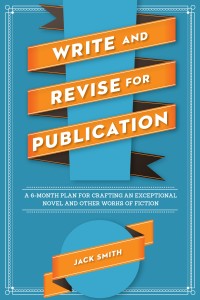Guest Post by Jack Smith
You have an interesting and compelling premise for your novel. Your logline is snappy and fetching. Your characters are complex with complex relationships between them. Your plot is lock-step, every thread tied up. Your setting is interesting.
Yet the writing itself isn’t working—it seems drab. A sample of ten to fifty pages will most likely not get past the agent or editor. Great idea, but needs considerable work. Give this thing some flair.
And so now is the time to do some major fine-tuning on the language itself.
What can you do? There are probably fifty things, but consider two general areas:
- Look at the pacing of your novel. I wouldn’t call pacing “flow” exactly because sometimes you don’t want the language to flow smoothly—and it’s possible to think of flow in this restricted sense—but don’t. After all, you might go for intense at times: bang, bang, bang, with a strong beat to it. Even monotonous at times (though watch this) if it’s in keeping with the character, who is decidedly monotonous. Still other times, it needs to be jerky, reflecting the mood or feeling of a character who’s about to lose it. The pacing needs to reflect the mood of the passage, whether it’s character thought or action. And it needs to move readers, keeping them gripped. How do you manage this? Here are a few possible techniques:
o Try varying your sentences. Choose long sentences for one effect, short ones for a different effect. In a scene, characters might answer each other in abbreviated replies or in long-winded replies (not easily managed unless you’re going for irony of some kind). Either choice will affect the pacing to create the kind of mood and tone you’re after. Varying your sentences will also create interesting variety for your reader.
o Use repetition of words, phrases, and sounds. This knits the language together and works nicely if the words or phrases are interesting. The risk, of course, is phrases that just create dull repetition. For repetition of sounds, make use of assonance and alliteration. I especially find that alliteration goes a long way in creating the texture of the prose.
- Look at the language itself. Does it have any flair, anything special about it, any interesting similes, metaphors, or analogies? Find ways to transform the writing so that it is colorful (anything but purple…) If the language is utterly quotidian, everything will be because this is the medium of the novel—language. I’ll back off on the figurative language suggestion and say that language which is highly specific and concrete—however the latter is achieved—goes a long way. It’s true that compelling imagery is often achieved by figurative comparison, yet well-chosen sharp detail can accomplish the same thing. Expository writing is particularly subject to dull language. Even if it’s character meditation, thought, and feelings of a sympathetic character, then the risk of mundane prose is ripe. To dress up internal “talk,” go for those concrete images as much as possible.
A novel with all the requisite ingredients—plot, character, setting—is only halfway there if the language itself gets in the way. The novel’s language needs to move readers. I’ve suggested only a few ways to fine-tune the novel’s language, but there are, of course, numerous things you can do. You can try stylistic elements like italics or capitalization; you can be creative with conventions such as quotation marks around dialogue; you can be elliptical in your narrative prose—as well as in your scenes. Do everything possible—that works, of course, with your particular novel—to charm your reader. Language is the medium.
Jack Smith is author of the novel Hog to Hog, which won the George Garrett Fiction Prize (Texas Review Press. 2008), and is also the author of Write and Revise for Publication: A 6-Month Plan for Crafting an Exceptional Novel and Other Works of Fiction, published earlier this year by Writer’s Digest. His novel ICON will be published in June by Serving House Books.
Prize (Texas Review Press. 2008), and is also the author of Write and Revise for Publication: A 6-Month Plan for Crafting an Exceptional Novel and Other Works of Fiction, published earlier this year by Writer’s Digest. His novel ICON will be published in June by Serving House Books.
Over the years, Smith’s short stories have appeared in North American Review, Night Train, Texas Review, and Southern Review, to name a few. He has also written some 20 articles for Novel & Short Story Writer’s Market, as well as a dozen or so pieces for The Writer.He has published reviews in numerous literary journals, including Ploughshares, Georgia Review, Missouri Review, Prairie Schooner, American Review, Mid-American Review, and the Iowa Review.
Great tips! I sometimes find myself feeling this way but then I place the dictionary in front of me and start reading. It inspires me to be more creative with the words I use.
Language is definitely a pull – and a big part of our voices. How we mesh those words together is so important :)
Great tips. This type of writing does make for fun reading. I especially like the varying sentences. When a book is filled with long sentences it tends to drag a bit.
Elizabeth – Thanks for hosting Jack.
Jack – These are really helpful ideas. It’s the phrases and words that the author uses that often invite the reader in. It makes sense to pay attention to them.
Pacing is such a hard thing to master. I think the most difficult part is actually acknowledging that sometimes you have to SLOW IT DOWN. I’ve learned enough tricks to speed it up over the last few years that my beta readers more often so, “hold it, can you give that a bit more?”–chapter or scene length is another thing I play with, though it seems to be most effective with PoV switches.
Jack–
Thanks for a useful summary. Figuring out how to rev up something that reads competent but no more is a very big issue.
All your points can be acted on by writers, but I would say the toughest is: “Look at the language itself. Does it have flair, anything special…?” Here, you are talking about what the French call “Je ne sais quois,” the “I don’t know what it is but I know it’s there” in stories and novels that go beyond competent.
The only way I know of to achieve this aspect is for the writer to identify those authors who most get to him through style, and read and reread them with great attention. The idea isn’t so much to imitate as to internalize the way favorite authors do what they do–and then to find some way to adapt it to one’s own style. But finding the “some way” is the trick.
Or so it seems to me.
Thanks, everyone. I really appreciate your remarks!
Elizabeth, thanks for having Jack over!
Jack, great article and technique on writing. I love using these techniques as well–it is important to write fresh, isn’t it?
:)
♥.•*¨Elizabeth¨*•.♥
Great advice! I try do do this in later drafts, once the story itself is nailed down. Thanks for the tips!